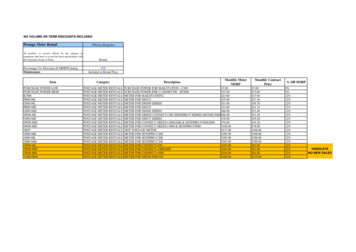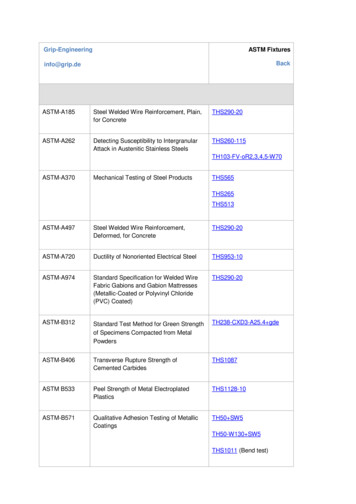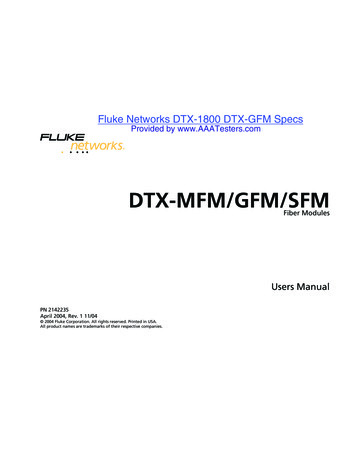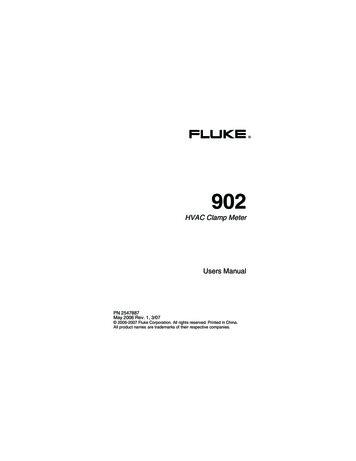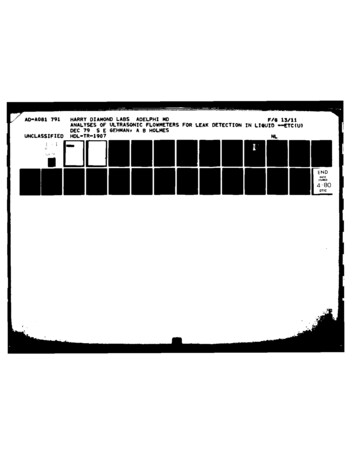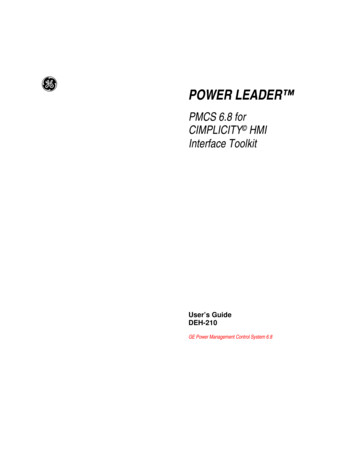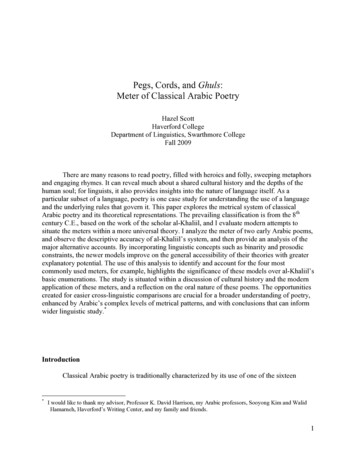
Transcription
Pegs, Cords, and Ghuls:Meter of Classical Arabic PoetryHazel ScottHaverford CollegeDepartment of Linguistics, Swarthmore CollegeFall 2009There are many reasons to read poetry, filled with heroics and folly, sweeping metaphorsand engaging rhymes. It can reveal much about a shared cultural history and the depths of thehuman soul; for linguists, it also provides insights into the nature of language itself. As aparticular subset of a language, poetry is one case study for understanding the use of a languageand the underlying rules that govern it. This paper explores the metrical system of classicalArabic poetry and its theoretical representations. The prevailing classification is from the 8thcentury C.E., based on the work of the scholar al-Khaliil, and I evaluate modern attempts tosituate the meters within a more universal theory. I analyze the meter of two early Arabic poems,and observe the descriptive accuracy of al-Khaliil’s system, and then provide an analysis of themajor alternative accounts. By incorporating linguistic concepts such as binarity and prosodicconstraints, the newer models improve on the general accessibility of their theories with greaterexplanatory potential. The use of this analysis to identify and account for the four mostcommonly used meters, for example, highlights the significance of these models over al-Khaliil’sbasic enumerations. The study is situated within a discussion of cultural history and the modernapplication of these meters, and a reflection on the oral nature of these poems. The opportunitiescreated for easier cross-linguistic comparisons are crucial for a broader understanding of poetry,enhanced by Arabic’s complex levels of metrical patterns, and with conclusions that can informwider linguistic study.*IntroductionClassical Arabic poetry is traditionally characterized by its use of one of the sixteen*I would like to thank my advisor, Professor K. David Harrison, my Arabic professors, Sooyong Kim and WalidHamarneh, Haverford’s Writing Center, and my family and friends.1
meters described by the grammarian al-Khaliil in the 8th century. This system is quantitative,relying on syllable weight and each meter is constructed from two basic units called watid(‘peg’) and sabab (‘cord’), which are each one to two syllables. Combinations of watid andsabab then form the different feet of a line that distinguish each meter. Al-Khaliil's system isfurther characterized by his arrangement of related meters, those differing only by the relativelocation of the watid within each foot, for example, into 'circles.' His model accurately describesmost classical poems, once the catalogue of variants is considered. I look at two early poemswritten in the waafir meter, one of the four most common meters, and show the general successof mapping from al-Khaliil's model. The problem remains, though, of how to best reconcile thissystem and its Arabic-specific units of representation with a more universal metrical theory, andhow to create a system that is explanatory, as well as descriptive. I evaluate the major modernlinguistic models with regards to these issues.Many have attempted a reformulation of al-Khaliil’s meters. Linguists such as Maling(1973) argue that a generative metric reanalysis of al-Khaliil's model is most successful. Shesuggests that his method of organizing meters into circles is necessary to account for why thereare exactly sixteen meters possible, and she supplements the system with specific generativerules. Others such as Prince (1989) and Schuh (1996) have continued to approach the analysismore universally. Prince emphasizes the importance of the metron, a phonological unit betweenthe foot and the hemistich, and reconstitutes watid and sabab in the modern inventory of Strongand Weak components. Schuh investigates the kaamil and basiit meters to show that a morebasic metric theory using the syllable as the metrical unit sufficiently accounts for therealizations of Arabic meter. Ultimately it is the work of Golston and Riad (1997), however,which best accounts for these meters. Their theory makes use of the metron level and shifts away2
from formulations based on watid and sabab. The emphasis on binarity further establishes theirclear and well-formulated account. Finally, the application of prosodic constraints CLASH andLAPSEto predict the four most commonly used meters is an example of this model’s superiorexplanatory potential.HistoryThe poems addressed in detail here are pre-Islamic and early Islamic, from a time whenArab society was predominantly tribal. Poetry was an integral and unifying part of the tribalculture as Alan Jones (1994) describes: “The poetry of a tribe was something that helped todifferentiate it from other tribes. It was a projection into words of the life of the tribe, itssolidarity and its aspirations, its fears and its sorrows.” (1). He further highlights poetry’simportance because of its ability to exist across time and space and writes, “[ ] poetry had aquality not possessed by a tribe's worldly possessions. Land, camels, goods and chattels, evenmembers of the tribe could be seized or destroyed by enemies, but as long as the collectivememory survived, so would the tribe's poetry.”( 1). These poems were not epic narratives in thespirit of the Iliad or Mahabharata, but were shorter, lyrical descriptions of everyday life. In“Ancient Arabian Poetry,” Charles Lyall suggests that the Greek idyll is the closestapproximation:The Arabian ode sets forth before us a series of pictures, drawn with confident skill andfirst-hand knowledge, of the life its maker lived, of the objects among which he moved,of his horse, his camel, the wild creatures of the wilderness, and of the landscape in themidst of which his life and theirs was set. (xviii)In achieving this significance, poems had one of four main purposes, with seven major themes.The purposes were: madih (‘panegyric’), hija' (‘lampoon’), ghazal (‘love’), and ritha (‘lament’),and themes: madih (‘panegyric’), hija' (‘lampoon’), ghazal (‘love’), ritha’ (‘lament’), waṣf3
(‘description’), fakhr (‘self-glorification’), and hikma (‘wise sayings’) (Jones 1994: 2). As such,this poetry addressed a wide range of subjects in daily life with relevance and significance to theentire community.Orality is another crucial component of this poetry. Scholars did not begin recordingthese poems in writing until the middle of the 8th century C.E. Even today, the phrase used bypoets remains qilt al-qasida (‘I uttered a poem’) and not katabt al-qasida (‘I wrote a poem’)(Monroe 1972: 13). At the time, poetry was experienced through shared recitations. Tribesgathered to hear rawi (‘reciters’). Rawi were known for their artistry, and poets who recite theirwork are compared to singing birds and their verses to birdsongs (Adonis 1990: 15). Therelationship of the rawi and poet was also like that of an apprentice; rawi would often becomepoets in their own right, though this was not a required stage in becoming a great poet. Lyallwrites, “The office of a rawi was not only to know the text of his master’s compositions, but alsoto be able to explain its allusions, to clear up its difficulties, and to relate the circumstances inwhich each poem was composed” (1885: xxxvi). Rawi preserved and transmitted the poeticcorpus.Contributing to the unifying nature of these poems, orality also influenced their form. Thepoets, themselves largely illiterate, relied on an “instinctive sense of rhythm” in theircomposition (Monroe 1972: 13). Monroe further argues that there are many facets of pre-Islamicpoetry which align with Albert Lord and Milman Parry’s critical analysis of oral composition.The use of formulae, which Parry defines as “a group of words which is regularly employedunder the same metrical conditions to express a given essential idea” (Lord 2000: 4), is afundamental example. Monroe finds a high percentage of formulae within 5000 lines of earlyArabic poetry. His findings are especially significant given that this percentage is about three4
times higher than what he found in written poems composed much later. This suggests that thefrequency of certain phrases is not merely related to the genre or subject matter, but more a resultof the particular method of composition. Monroe also cites reports that Arab poets used bowsand staffs during recitation for emphasis and possibly as a rhythmic aid. This external use ofrhythm is crucial in oral composition, as Lord and Parry find with regard to the use of thestringed gusle in the Yugoslav oral epic. A further characteristic of oral poetry is its “fluidity andmultiformity,” and, as R. Menedez Pidal writes, it is “a poetry that lives through variants”(Zwettler 1978: 189). Although early Arabic poems were short enough as to eventually lead totheir memorization, pure memorization was not the primary means of expressing a poem, anddifferent versions abounded. In collecting poems, medieval scholars often distrusted the differentinformants who recited slightly different versions of the poems (Monroe 1972: 10), but nowthere is a better understanding of the genre, with less emphasis on locating the ‘original.’ Monroesuggests approaching a poem as “probably not an exact recording of what a great poet once said,but a fairly close picture of it, distorted by the vicissitudes of an oral transmission in which bothmemorization and ‘de-paganization’ were operative and further complicated by a tradition ofscribal correction” (1972: 41).With this approach in mind, I address two early Arabic poems in detail, both of which arefrom the same time period and composed in the same meter. The poets and their subject mattersdiffer, and together these poems are a representative sliver of great early Arabic poetry. The firstpoem, by al-Khansa, is a sixteen line qasida, “Rith'a Ṣakhr.”1 Al-Khansa was a well-regardedpoet from early Islam who lived from around 590 C.E. to 670 C.E., at the latest. She won poetrycontests, and it is said that Muhammad often asked her to recite poems for him (Bezirgan et al1See Appendix for full Arabic text and English translation, both from Jones 1994.5
1977: 4).Al-Khansa began composing poems after the death of a brother and almost all of herpoems are laments, one of the four main poetic purposes. “Rith'a Ṣakhr”, in particular, is a wellknown poem for her dead brother Ṣakhr, composed in the early to mid 7th century.The other poem, “Qiṭ'a Nuniyya,” was composed by Ta'abbaṭa Sharran. His name means“he carried a mischief under his arm” (Lyall 1885: 15), and he was known for his adventures and“rogue” nature and poems. This poem is considered fakhr (‘self-glorification’) because it is adescription of his victorious encounter with a ghul, one of the malevolent species of jinn. Jinnare spirits, one of the intelligent beings, other than humans and angels, created by Allah.Benevolent jinn include those of poetry, as each poet was thought to have his own jinni (Jones1994). Ghuls, however, are known for changing shapes and luring travelers astray in the desert.As described in this poem, ghul can be killed in one blow, but one must be brave enough not tohit again as a second strike brings the ghul back to life.Meter and al-KhaliilIn their common themes and shared tradition of oral composition, early Arabic poemstook on similar forms. Shorter poems, qita', were 7-10 lines, but the more common andimportant, especially by the end of the 6th century, was the qasida (‘ode’) which can range up to120 lines. These forms are characterized by their meter and rhyme. Each line is divided into twohalf lines, or hemistichs. A metrical pattern describes one hemistich, and this pattern is repeatedin each hemistich throughout the poem. In writing, the poetic line is represented with a largespace between its hemistichs. With recitation there is generally no discernable pause betweenhemistichs, but their existence is noted by the repetition of the meter and the rarity ofenjambment, when a syntactic unit splits across a line or hemistich break (Monroe 1972: 27).6
Other than the occasional gimmick or instructional piece, a poem will employ a single meter. Allpoems also make use of a single end line rhyme, and very often the first hemistich of the poemshares that rhyme as well. Case inflections are suffixing, so rhyme is not too difficult, but it isstill an essential component of the poetic form. The modern poet Adonis writes:Rhyme was the basic element which distinguished pre-Islamic Arabic poetry from thepoetry of other peoples. Neither in Aramaic, Syriac, Hebrew or Greek was it consideredan essential feature of poetry in the way it was for the Arabs. Because of this, the ancientArabic critics maintained that the structure of pre-Islamic prosody was not an imitation ofthat of any other nation but was exclusive to the Arabs. (30)The meter in Arabic poetry is quantitative, as in ancient Greek and Latin poetry. It is asystem that makes use of an intermediary unit, the foot, within which are patterns of syllablesbased on their length. Similar systems pattern tone or stress instead, as in iambic pentameter inEnglish, where each foot is a pair of syllables with a weak-strong stress sequence. These are incontrast with other metrical systems that are based on counting the number of syllables in eachline, such as in the Japanese haiku.Al-Khaliil ibn Ahmad al-Farahidi is revered for his scholarship on the Arabic languageand was responsible for the first and most well-established account of meter in early Arabicpoetry. In addition to his work on poetics, he is known for compiling the first Arabic dictionary(Kitab al-‘ayn) and for his contributions to the standard Arabic grammar published by Sibawaih,one of his students. He was born in Oman, but lived most of his life in Basra, the center ofArabic language research, and died in 791 C.E. He was profoundly pious, refused officialpatronage, and took seriously his duty to learn and teach (Carter 1998). His system remains thestandard authority of describing the meters of classical Arabic poetry.Al-Khaliil’s metrical analysis is internal to the Arabic language so I will discuss histerminology, with a brief translation into syllables, and then present the sixteen meters. In7
constructing the meters, Al-Khaliil did not use syllables, at the time Arab scholars did not usethat concept explicitly, but instead relied on units called watid (‘peg’) and sabab (‘cord’).These combine to form feet (tafa’il), two to four of which constitute one hemistich. A line ofverse is called bayt (‘house’ or ‘tent’) and consists of two hemistichs. As a note on the structuralmetaphor, consider the necessity of pegs and cords in constructing a tent, with many possiblearrangements. It has also been suggested that pegs are solid and invariant, whereas cords can betight or loose, a possible reflection on the variations, or lack thereof, within their ownconstruction (Maling 1973).To understand the components of watid and sabab it is necessary to recognize thedecomposition of Arabic letters into ‘movement letters’ and ‘silent letters.’ It is helpful to framethis distinction within written Arabic, where short vowels, a, i, u, are marked only as optionaldiacritics. A movement letter is a letter (that is, a consonant or the semi-vowels w and y) with ashort vowel. A silent letter is one marked with a sukun, creating either an isolated consonant or along vowel (Encyclopedia of Arabic Language and Literature). For example, kitaab (‘book’) iswritten with four main letters: k-t-a-b. K is a movement letter as it is followed with the shortvowel i,and so is t with its short vowel a. A, a long vowel, and b are both silent letters as theyhave no vowel following. This is not static: in kitaabii ‘my book’, written k-t-a-b-i, b is amovement letter instead.Watid and sabab are each two or three letters. A sabab is composed of one movementletter then a silent letter, or two movement letters. For example, fii (‘in’) is a sabab composed ofthe movement letter f followed by the silent long vowel i. Given the orthography, sabab isalways written with two letters. Watid is composed of two movement letters then a silent letter,or two movement letters with a silent letter in between. For example, ‘alaa (‘on’) is a watid with8
‘ and l as the movement letters and the final a is the silent letter. Watid are always three letters(al-Bustaanii 1962).This is the traditional Arabic approach, but these terms can also be understood withstandard syllables and sequences of consonants (C) and vowels (V). Movement letters are alwaysCV, which is a short syllable. Consonant clusters are not permitted in Arabic so a movementletter followed by silent letters creates a long syllable, either CVV, CVC, or CVVC.RogerFinch (1984) has offered a slightly different formulation, which considers the dichotomy toinstead be of open versus closed syllables. A movement letter is simply an open syllable andCVC is closed. He argues that long vowels can be analyzed as a short vowel followed by ahomorganic glide (/ah/, /iy/, /uw/) and can thus be analyzed as a closed syllable. This is acompelling suggestion, and interesting for the implied distinction from the durational metrics ofGreek and Latin, but for the purposes here the classification of syllables as long and short issufficient. In the table and discussion to follow, I will adopt the notation for short syllable, forlong syllable, and P for watid and K for sabab. The last is standard and presumably an allusion tothe initial sounds of the English translations.Given this translation into syllables, it follows that sabab can be described as a longsyllable, and watid is a sequence of a short and long syllable. This syllabic formulation isstandard in modern linguistic discussions and preserves the uniqueness and ingenuity of alKhaliil’s work while improving general accessibility. For further illustration of the watid andsabab, consider the first line of Qiṭ'a Nuniyya:(1)ʔalaa man mubligun fitaiana fahminbimaa laaqaitu 'inda rahaa bitaani'Come, who will convey to the young men of Fahm the news of what I encountered faceto face at Raha Bitan?'The first word ʔalaa ('come') is two syllables, ʔa-laa, which are CV and CVV. This is a short,9
long sequence so the entire word is a watid. Man ('who') is a long syllable, CVC, so it constitutesa sabab. It is not imperative that the syllables of a watid occur in the same word. For example,the fourth and fifth words of this line have a watid across their boundary, fitaina fahmin.Combinations of sabab and watid form the feet of a meter. Al-Khaliil represented theeight basic feet with variations of the bare form F ‘ L. This provides a rhythmic way ofremembering the meters and their variants, and also parallels the manipulation of F ‘ L used inexplaining grammatical patterns. For example, the tawiil meter is:fa’uulun mafaa’iilun fa’uulun mafaa’iilun PK /PK K/PK /PKKThe sixteen meters of al-Khaliil follow. Table 1 organizes the meters using the Arabicwords (al-Bustaani 1962) and the modern transformation from Prince (1989). Each columnconsists of the pattern for one hemistich, which is repeated to make the line. This includes someof the possible variants: L represents a location where a sabab can be two short syllables, and Qis the inversion of watid. A summary of the notation also follows.TABLE 1:CircleMeterI.tawiilPK PKK PK PKKfa’uulun mafaa’iilun fa’uulun mafaa’iilunbasiitKKP KP KKP (KP)mustaf'ilun faa’ilun mustaf'ilun faa’ilunmadiidKPK KP KPK (KP)faa'ilaatun faa’ilun faa’ilaatunwaafirPLK PLK PLKmufaa'alatun mufaa’alatun fa’uulunkaamilLKP LKP (LKP)mutafaa’ilun mutafaa’ilun mutafaa’ilunhazajPKK PKK PKKmufaa'iilun mufaa'iilun mufaa'iilunrajazKKP KKP (KKP)mustaf'ilun mustaf'ilun mustaf'ilunramalKPK KPK (KPK)faa'ilaatun faa'ilaatun faa’ilunmunsarihKKP KKQ KKPmustaf'ilun maf’uulaatu mustaf’ilunkhafiifKPK KQK (KPK)faa'ilaatun mustaf’ilun faa'ilaatunII.III.IV.10
V.muqtadabKKQ KKPmaf'uulaatu mustaf’ilunmujtaɵɵKQK KPKmustaf'ilun faa'ilaatunmudaari'PKK QKKmufaa’iilun faa’ilaatunsarii'KKP KKP KKQmustaf'ilun mustaf'ilun maf’uulaatumutaqaarib PK PK PK PKfa'uulun fa'uulun fa'uulun fa'uulunmutadaarik KP KP KP (KP)faa'ilun faa’ilun faa’ilun faa’ilunTABLE 2: SUMMARY OF NOTATION Watid/PSabab/KLQCVCVC; CVV; CVVC One final component of al-Khaliil's work is his organization of related meters into thefive different circles. This reflects that when written circularly, the first meter of a circle cangenerate the other meters of that circle by selecting distinct starting points. For example, inCircle I the three meters all alternate feet of two and three units, varieties of PK PKK. Thediagram below shows the three meters of Circle I, with each beginning at a different colon.Starting clockwise from the left is tawiil, madiid, and basiit.DIAGRAM 1: RELATIONSHIP OF CIRCLE I METERSThis circle model overgenerates and alone does not predict which sequences are11
acceptable, but it does show an important relationship between extant meters. This abstraction isone of the strengths of al-Khaliil’s work because it condenses the system and attempts anadditional level of organization. As Maling writes, “[ ] al-Xalil's system of circles is not only asimple, elegant, and insightful analysis of the meters, but [ ] it provides the only basis for anadequate metrical description of Arabic verse” (1973: 12). Others find that it simply adds to theinaccessibility of this model.Tawiil was the most prevalent meter used in Arabic poetry, and the next three mostcommon are kaamil, waafir and basiit. Golston and Riad cite two different corpora, Vadet andStoetzer, which place tawiil as the meter of either 50.4% or 35% poems, respectively. Vadet usesalmost 2300 poems and fragments and Stoetzer draws from 130 poems from the 8th century.These four meters together make up 80-90% of the meters used.The two poems examined here are written in the waafir meter:mufaa’alatun mufaa’alatun fa’uulun PL K /PL K/PKWaafir is one of the two meters in Circle II, the only group in which two short syllablescan be substituted for a sabab. This variation is only permitted in the first sabab of each foot,though. This and other variations will be discussed as they appear, with reference to al-Khaliil’svariations as recorded in works such as al-Bustaani’s al-Bayan.Ritha’ Ṣakhr“Ritha’ Ṣakhr” follows, line by line.2 I have analyzed its metrical structure and coded thecomponent parts. The first line is separated into syllables, with its syllabic components and each2Another version of this poem in Arabic from the website adab.com shows a few differences. That version omittedwhat is line 6 here, and line 9 appeared as its 13th line. There were four lexical variations: alternations betweenwa and fa- (both ‘and’) and a different verb meaning ‘console’ was used in line 14.12
length ( or ), followed by the P or K unit. From this point, K is written for both L and K forsimplicity; the pattern remains unchanged. The remaining lines also list syllable length and P andK and foot boundaries are marked with / . All lines are followed by Jones’s translation, then adiscussion of my scansion.(1)yu war ri qu nii–al ta thak ku ru hii na ʔum siicv cvc cv cv cvvc cv cvc cv cv cvv cv cvc cvv PKK/PKK/PKfa ʔus bi hu qad bu lii tu bi far ti nuk siicv cvc cv cv cvc cv cvv cv cv cvc cv cvc cvv PKK/PKK/PK'In the evening remembrance keeps me awake, and in the morning I am worn out by theoverwhelming disaster [that has befallen us],’Note that the first sabab is made up of two short syllables ri-qu, rather than one longsyllable. The effects of elision in Arabic also show in scanning this line, a reminder of theimportance of orality in this poetry. In speech, the vowel of the definite article al is elided whenpreceded by a vowel, and assimilation of the l occurs when it precedes ‘sun letters’ (e.g. t, s, sh,r, th, d). In this line, al-tathakkuru means 'the remembrance' where the final u is a subject casemarker, and al marks its definiteness. Assimilation alone yields the pronunciation at-tathakkuru.It is preceded by a vowel, i, in yuwariqu.nii (‘keeps me awake’) so the final pronunciation is yuwar-ri-qu-niit-ta-thak-ku-ru. Interpreting this sequence successfully is crucial for scanning themeter correctly:yu war ri qu niit ta thak ku rucv cvc cv cv cvvc cv cvc cv cvPKK /PKNeither eliding nor assimilating results in the incorrect sequence:*yu war ri qu nii ʔal ta thak ku rucv cvc cv cv cvv cvc cv cvc cv cvPKK K PK13
This line, as in the remaining 15 lines of the poem, ends with a degenerate PK foot ratherthan the theoretical PLK foot.Both hemistichs end with sii, satisfying the condition that hemistichs of the first linerhyme.(2)'alaa ṣakhrin waʔayyu fatan kaṣakhrin PK K/PK K /PKliyaumi kariihatin wati'aani khalsi PK K/PK K/PK'In the case of Ṣakhr, and what youth is there like Ṣakhr to deal with a day of warring and skillfulspear-thrust'This line does not use the sabab option in each foot, as occurred in the first line. Bothhemistichs also lack the final sabab. This line also ends with what should be a short syllable, si.It is an overwhelming assumption that a short syllable at the end of a line should be scanned aslong, however. This reflects Arabic convention that both syllable length and the pronunciation ofdiacritics is variable before a natural pause. Maling also suggests that a CV sequence isconsidered a short syllable only if it is directly followed by a single C and V. She argues thisparallels Halle’s analysis of classical Greek meter, and provides a sufficient explanation for whyend syllables are always long (1973: 20).Si rhymes with sii from the first line and the end rhyme is maintained.(3)walilkhasmi-alʔaladdi ʔithaa ta'addai PK K/PK K/PKliyaʔkhuthu haqqa mathluumin biqinsi PKK/PK K/P K'And to deal with tenacious opponents when they transgress, so that he can assert the right ofsomeone on whom oppression has fallen?'(4)falam ʔara mithlahu ruzʔan lijinnii PK K / P K K/ P Kwalam ʔara mithlahu ruzʔan liʔinsi PK K/PK K /P K14
'I have not seen his like in the extent of [the] disaster [caused by] his death, either among jinn oramong men'Line (4) is interesting for its treatment of hu, the masculine suffix. Based on theorthography it appears to be a short syllable, written with one letter. The location in the metricalsequence suggests it would be a long syllable, however. This is precisely one of the phonologicalsegments that should be interpreted counter to its written realization. Hu, as a pronoun followinga short vowel (such as in mith-la ‘like-him’), is scanned as a long syllable; if it follows a silentletter (such as in min-hu ‘from-him’), this interpretation is optional (al-Bustaani 1962). Thefeminine suffix is written haa, with a long vowel, and perhaps hu more closely paralleled this inthe past. Willem Stoetzer also addresses this particular issue in “Some Observations on Quantityin Arabic Metrics” where he concludes that hu is a long syllable. He compared historicalexamples of verse written traditionally and “prosodically” to show that hu does have a longvowel. Using this interpretation resolved over 90% of all the differences he found between thetheoretic meter and almost 1900 feet written in the waafir and kaamil meters.(5)ʔashadda ‘alaa ṣuruufi-aldahri ʔaidan PK K/ P KK/ PKwaʔafṣala fii-alkhuṭuubi bighairi labsi PK K/ PK K/P K‘Truly strong against the vicissitudes of fortune and decisive in affairs, showing no confusion’6)waʔakramu ‘inda ḍurri-alnaasi jahdan PKK/P K K/ PKlijaadin ʔaw lijaarin ʔaw li’irsi PK K/PK K/PK‘At times when people were suffering hardship most generous in his endeavours towards thosewho sought help or towards neighbours or to his wife.’(7)waḍaifin ṭaariqin ʔaw mustajiirin PKK/PKK/PKyurawwa’u qalbuhu min kulli jarsi PK K/PK K /PK15
“Many was the guest who arrived by night or the man who was seeking protection, [people]whose hearts were alarmed at every sound.”The second hemistich contains another example of hu appearing as a long syllable inqalbuhu.(8)faʔakramahu waʔamanahu faʔamsaa PKK/ PK K/PKkhaliiyan baaluhu min kulli buʔsi PK K /PK K/ PK‘He treated [such people] kindly and made them safe, so that their state was free from everypressing need.’(9)falaa yaa ṣakhru laa ʔandaaka PKK/ PK K/Phattaa Kʔugaariqa muhjatii wayushaqqa ramsii PK K/PKK/PK‘Ah, O Ṣakhr, I shall [never] forget you until I part from my soul and my grave is cut.’(10)yudhakkirunii ṭuluu’u-alshamsi ṣakhran PK K/PK K/PKwaʔadhkuruhu likulli ghuruubi shamsi PK K/P K K/PK“The rising of the sun reminds me of Ṣakhr, and I remember him every time the sun sets.”The first hemistich contains another example of elision and assimilation. Althoughwritten tuluu’u al-shamsi, the correct pronunciation and syllabic breakdown with assimilationbecomes tu luu ’u ash sham si and then finally tu luu ‘ush sham si with elision.(11)falawlaa kathratu-albaakiina hawlii PKK/PK K/ PK‘alaa ʔikhwaanihim laqataltu nafsii PKK /PK K /P K‘But for the multitude of people around me weeping for their kin I would have killed myself.16
(12)walaakin laa ʔazaalu ʔaraa ‘ajuulan PKK/PKK /PKwanaaʔiḥatan tubuuḥu liyawmi naḥsi PK K/PK K/PK‘All the time I can see the woman grieving for her dead child and the woman wailing over thedeath of her husband on a day of misfortune.’(13)humaa kiltaahumaa tabkii ʔakhaahaa PKK/PKK/PK‘ashiyyata ruzʔihi ʔaw ghibba ʔamsi PK
The poems addressed in detail here are pre-Islamic and early Islamic, from a time when Arab society was predominantly tribal. Poetry was an integral and unifying part of the tribal culture as Alan Jones (1994) describes: “The poetry of a tribe was som

